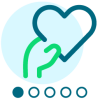Web Optimization: Creating A Website That Works
Creating a Website that Works
“Design is not how it looks and feels. Design is how it works.” -Steve Jobs
A website is (or should be) much more than a pretty picture. It is often the first impression someone has of your organization. It is a vehicle to tell your story, engage visitors and lead them to take some sort of action. A website that works includes…
INTUITIVE USER EXPERIENCE
An intuitive user experience is one that enables your visitors to get what they need. It allows you to create stronger relationships, drive deeper engagement and insight action.
Set Goals
Start by creating a baseline. Google Analytics contains a wealth of information to show you what is happening on your site today. Where are site visitors coming from? How do they find you? What types of devices are they on? Where are they spending time (and where are they not)? Are they taking action?
When we think about an intuitive user experience, it is critical to understand the goals of the website. What do YOU want people to do when they come to your site? You can derive these actions from your organization goals. Not only should you create goals, take the next step and develop specific and measurable key performance indicators (KPIs), so you can evaluate your progress.
Here are a few examples:
Website Goal: Tell the story of the cultural sector and our role in it.
KPIs: Increased donations, increased social media shares, increase in session durations
Website Goal: Increase donor retention
KPIs: Increase donor retention by 20% by June 30, 2018
Who Is Your Audience?
You have goals for your website. But, let’s be honest. Your website is really for the visitors. They need to be a top priority! On the flipside, for you to effectively communicate and achieve your goals, it’s important to realize you can’t be all things to all people. Narrow down your audience to the top five groups. And then really get to know them.
Personas are really powerful here. Good personas make the difference between doing the upfront work to get it right the first time and spending the same money or more with multiple redesigns, increased costs, etc. Persona work is focused on creating a deeper understanding of your audience’s lifestyle, motivations and behaviors. By getting to know them - why they do the things they do, what they expect from your organization – you can serve them better. Knowing them enables you to connect on a personal level and provide them with a richer experience. And, personas expand across communication channels. Not only will they make your website more effective, they will also improve open and click-through rates in your email communications.
Create a navigation system informed by your audience
Don’t make decisions on the website in a vacuum (or a board room). Not only is it important to think like your audience group, it is important to get their input. Soliciting user-generated input on your content and information architecture is incredibly valuable in creating an effective site map and navigation structure. Card sorting is one technique that is useful in getting this input. They can be done in-person or leveraging online card sort tools, like Optimal Sort. This data will help inform the site map and structure of the site.
By defining your goals, getting to know your audience and gathering user input, you will be able to create an experience on your website that is tailored to your audience’s needs, but also one that drives forward the strategy and goals of your organization.
VISUALLY ENGAGING RESPONSIVE DESIGN
An engaging design is one that meets your visitors where they are and compels them to further interact with you! Responsive design, one that responds according to the device the user is on, is no longer an option…it is a necessity. Mobile use has now surpassed desktop (StatCounter Global Stats), which means more people are accessing your website from their mobile devices than a desktop! And, if that doesn’t convince you, a study conducted by Blackbaud showed an average of 34% increase in conversion rates when an organization had a responsive website and donation form. I think we can all agree there are very few things, if any, you can do to drive that kind of improvement in your conversion rate!
Engagement is also about creating a relationship with the user. A few best-practices...
TESTING & EVOLVING
A website is not something to be designed and left. Testing and evolving is a critical, often missed, step in creating a website that works. There are many ways to test your content and the user experience. Here are a few to explore...
Of course, also make sure you have Google Analytics set up on your site to track unique visitors, page views, bounce rate, content, traffic sources, average time on site, etc.
At the end of the day, testing a site is looking at the goals and KPIs you initially set and the engagement and conversions you are looking to drive. It provides a way to see what is working and identify opportunities to improve and evolve. Keeping up with the latest trends (see Aga’s post on 2017 Trends) and deciding which ones might be right for you, will also keep your site fresh and give visitors a reason to come back!
Whether you are embarking on a website redesign or just looking for ways to improve your current site, set goals, keep your audience at the forefront and test!
Written by: Brooke Hansel, Blackbaud Interactive Services Team
Are you up to date on the latest web trends? Sometimes a site is one feature away from making it big—Let us help you optimize your web experience with the help of Blackbaud's Interactive Services Team.
We love a good website. Check out our Web Design Lookbook for 10 more tips you should consider when optimizing your site experience.
“Design is not how it looks and feels. Design is how it works.” -Steve Jobs
A website is (or should be) much more than a pretty picture. It is often the first impression someone has of your organization. It is a vehicle to tell your story, engage visitors and lead them to take some sort of action. A website that works includes…
- An intuitive user experience
- A visually engaging responsive design
- Testing & Evolving
INTUITIVE USER EXPERIENCE
An intuitive user experience is one that enables your visitors to get what they need. It allows you to create stronger relationships, drive deeper engagement and insight action.
Set Goals
Start by creating a baseline. Google Analytics contains a wealth of information to show you what is happening on your site today. Where are site visitors coming from? How do they find you? What types of devices are they on? Where are they spending time (and where are they not)? Are they taking action?
When we think about an intuitive user experience, it is critical to understand the goals of the website. What do YOU want people to do when they come to your site? You can derive these actions from your organization goals. Not only should you create goals, take the next step and develop specific and measurable key performance indicators (KPIs), so you can evaluate your progress.
Here are a few examples:
Website Goal: Tell the story of the cultural sector and our role in it.
KPIs: Increased donations, increased social media shares, increase in session durations
Website Goal: Increase donor retention
KPIs: Increase donor retention by 20% by June 30, 2018
Who Is Your Audience?
You have goals for your website. But, let’s be honest. Your website is really for the visitors. They need to be a top priority! On the flipside, for you to effectively communicate and achieve your goals, it’s important to realize you can’t be all things to all people. Narrow down your audience to the top five groups. And then really get to know them.
Personas are really powerful here. Good personas make the difference between doing the upfront work to get it right the first time and spending the same money or more with multiple redesigns, increased costs, etc. Persona work is focused on creating a deeper understanding of your audience’s lifestyle, motivations and behaviors. By getting to know them - why they do the things they do, what they expect from your organization – you can serve them better. Knowing them enables you to connect on a personal level and provide them with a richer experience. And, personas expand across communication channels. Not only will they make your website more effective, they will also improve open and click-through rates in your email communications.
Create a navigation system informed by your audience
Don’t make decisions on the website in a vacuum (or a board room). Not only is it important to think like your audience group, it is important to get their input. Soliciting user-generated input on your content and information architecture is incredibly valuable in creating an effective site map and navigation structure. Card sorting is one technique that is useful in getting this input. They can be done in-person or leveraging online card sort tools, like Optimal Sort. This data will help inform the site map and structure of the site.
By defining your goals, getting to know your audience and gathering user input, you will be able to create an experience on your website that is tailored to your audience’s needs, but also one that drives forward the strategy and goals of your organization.
VISUALLY ENGAGING RESPONSIVE DESIGN
An engaging design is one that meets your visitors where they are and compels them to further interact with you! Responsive design, one that responds according to the device the user is on, is no longer an option…it is a necessity. Mobile use has now surpassed desktop (StatCounter Global Stats), which means more people are accessing your website from their mobile devices than a desktop! And, if that doesn’t convince you, a study conducted by Blackbaud showed an average of 34% increase in conversion rates when an organization had a responsive website and donation form. I think we can all agree there are very few things, if any, you can do to drive that kind of improvement in your conversion rate!
Engagement is also about creating a relationship with the user. A few best-practices...
- Make sure your mission is front and center - Your supporters and visitors should immediately know your core focus and values.
- Showcase Impact - Users want to easily see the impact of your work.
- Clear, bold calls to action – These are ways to further engage the user. Include directive text and a link on prominent imagery. Nudge the user along. Remove all obstacles - “Donate” should go directly to the donation form! And, keep it simple - instead of “click here to learn more about our programs” just say “learn more.”
TESTING & EVOLVING
A website is not something to be designed and left. Testing and evolving is a critical, often missed, step in creating a website that works. There are many ways to test your content and the user experience. Here are a few to explore...
- 5 second test - measure people’s first impressions. This type of test can be used to test home page designs, landing pages, logos, brochures and marketing material. Wherever first impressions count, use a five second test.
- How? Share a static image and show the design for 5 seconds. When time is up ask the participant what they recall and/or what they remembered. Commonly occurring keywords will provide insight into the first impression. A word cloud is a fun tool to use here!
- Navigation test - measure effectiveness of navigation. This type of test is ideal for testing process flows (online donation, ticket purchase, event registration, membership signup)
- How? Give users a task to carry out. Measure how far they progress, the pathway they take, where they click. This will help identify bottlenecks and usability issues.
Of course, also make sure you have Google Analytics set up on your site to track unique visitors, page views, bounce rate, content, traffic sources, average time on site, etc.
At the end of the day, testing a site is looking at the goals and KPIs you initially set and the engagement and conversions you are looking to drive. It provides a way to see what is working and identify opportunities to improve and evolve. Keeping up with the latest trends (see Aga’s post on 2017 Trends) and deciding which ones might be right for you, will also keep your site fresh and give visitors a reason to come back!
Whether you are embarking on a website redesign or just looking for ways to improve your current site, set goals, keep your audience at the forefront and test!
Written by: Brooke Hansel, Blackbaud Interactive Services Team
Are you up to date on the latest web trends? Sometimes a site is one feature away from making it big—Let us help you optimize your web experience with the help of Blackbaud's Interactive Services Team.
We love a good website. Check out our Web Design Lookbook for 10 more tips you should consider when optimizing your site experience.
0
Comments
-
Is it possible to add Google Analytics code to Altru event/donation forms?0
Categories
- All Categories
- 6 Blackbaud Community Help
- 209 bbcon®
- 1.4K Blackbaud Altru®
- 395 Blackbaud Award Management™ and Blackbaud Stewardship Management™
- 1.1K Blackbaud CRM™ and Blackbaud Internet Solutions™
- 15 donorCentrics®
- 359 Blackbaud eTapestry®
- 2.5K Blackbaud Financial Edge NXT®
- 646 Blackbaud Grantmaking™
- 564 Blackbaud Education Management Solutions for Higher Education
- 3.2K Blackbaud Education Management Solutions for K-12 Schools
- 934 Blackbaud Luminate Online® and Blackbaud TeamRaiser®
- 84 JustGiving® from Blackbaud®
- 6.4K Blackbaud Raiser's Edge NXT®
- 3.7K SKY Developer
- 243 ResearchPoint™
- 118 Blackbaud Tuition Management™
- 165 Organizational Best Practices
- 238 The Tap (Just for Fun)
- 33 Blackbaud Community Challenges
- 28 PowerUp Challenges
- 3 (Open) Raiser's Edge NXT PowerUp Challenge: Product Update Briefing
- 3 (Closed) Raiser's Edge NXT PowerUp Challenge: Standard Reports+
- 3 (Closed) Raiser's Edge NXT PowerUp Challenge: Email Marketing
- 3 (Closed) Raiser's Edge NXT PowerUp Challenge: Gift Management
- 4 (Closed) Raiser's Edge NXT PowerUp Challenge: Event Management
- 3 (Closed) Raiser's Edge NXT PowerUp Challenge: Home Page
- 4 (Closed) Raiser's Edge NXT PowerUp Challenge: Standard Reports
- 4 (Closed) Raiser's Edge NXT PowerUp Challenge: Query
- 779 Community News
- 2.9K Jobs Board
- 53 Blackbaud SKY® Reporting Announcements
- 47 Blackbaud CRM Higher Ed Product Advisory Group (HE PAG)
- 19 Blackbaud CRM Product Advisory Group (BBCRM PAG)




